Utilizing Energy Storage for Reliability Solutions in Active Distribution Systems
Abstract
:1. Introduction
2. Quantification of Reliability Events
| Algorithm 1: Quantification of reliability events. |
|
3. Scenario-Based Probabilistic Modeling of Reliability Solutions with ESS
| Algorithm 2: Probabilistic modeling of reliability event mitigation with the ESS. |
|
| Algorithm 3: Integration of model developed in Algorithm 2 into the reliability assessment framework. |
|
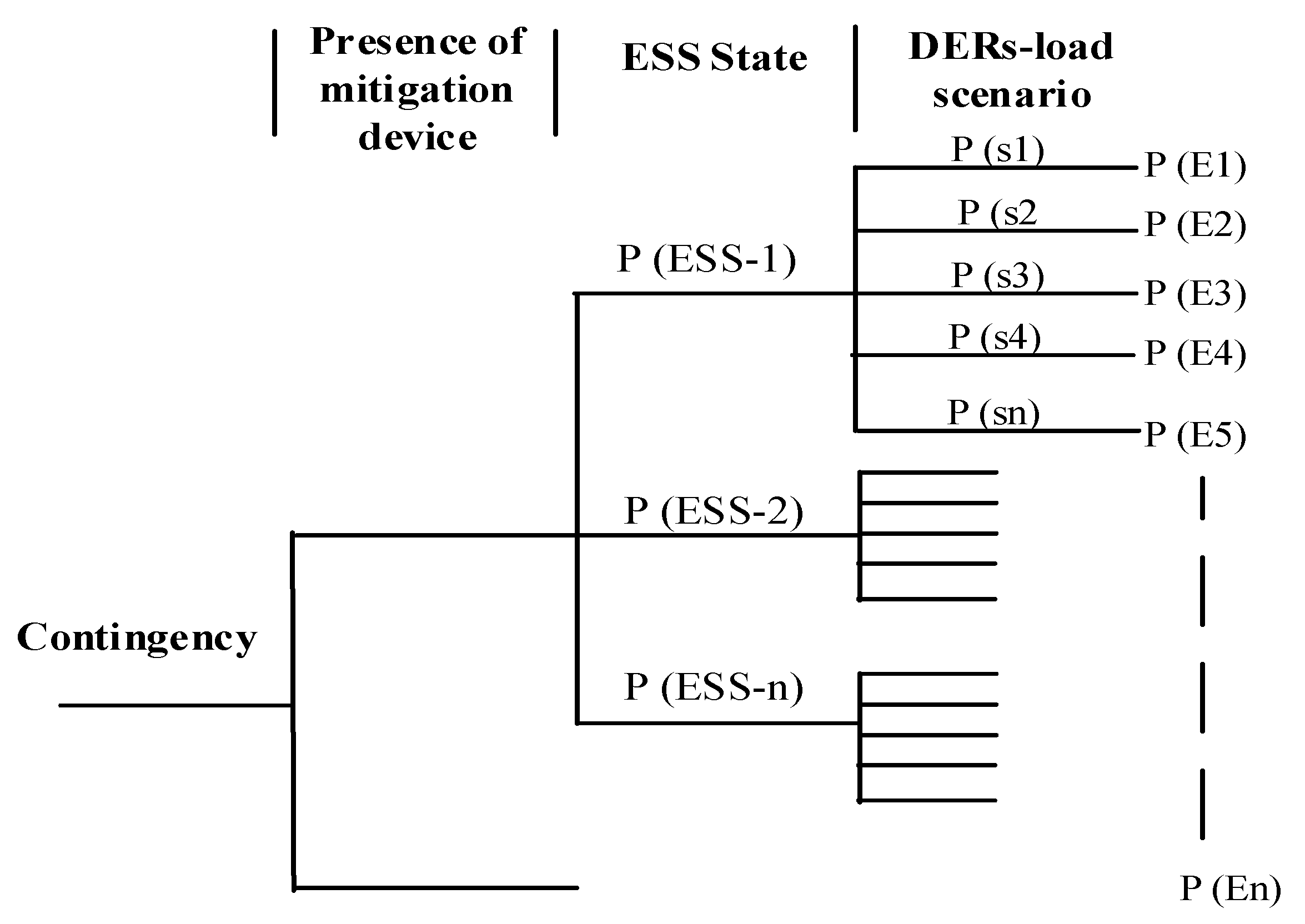
4. Case Studies and Discussion
4.1. End-User Reliability Profile with ESS
4.2. DERs/Microgrids and Reliability Improvement
5. Conclusions
Author Contributions
Funding
Conflicts of Interest
Nomenclature
| Index of load point and set of network load points. | |
| Number of customers at load point . | |
| Total number of customers in a network under consideration. | |
| Index of contingency; where denotes temporary and permanent failure. | |
| Disruptive voltage sags, momentary, and sustained interruptions, respectively. | |
| Reliability event; . | |
| Magnitude of voltage sag. | |
| Duration of voltage sag. | |
| Rate of occurrence of (occ/yr). | |
| Set of load points experiencing due to . | |
| Interruption time for load point experiencing due to (hr). | |
| Frequency of occurrence of for due to considering DERs/microgrids (occ/yr). | |
| Value of without considering DERs/microgrids (occ/yr). | |
| Unavailability due to for due to considering DERs/microgrids (hr/yr). | |
| Value of without considering DERs/microgrids (hr/yr). | |
| Damage cost of RE for due to (k$/yr). | |
| Probability of reliability event () caused by not being mitigated for . | |
| Frequency of occurrence of for load point (occ/yr). | |
| System frequency index for of (occ/cust-yr). | |
| System index of unavailability of (hr/cust-yr). | |
| Damage cost due to for (k$/yr). | |
| Total damage cost due to all the reliability events for (k$/yr). | |
| System index of customer damage cost due to (k$/yr). | |
| Total system damage cost due to all the reliability events (k$/yr). |
References
- LaCommare, K.H.; Eto, J.H. Understanding the Cost of Power Interruptions to US Electricity Consumers; Lawrence Berkeley National Lab.(LBNL): Berkeley, CA, USA, 2004. [Google Scholar]
- Ortmeyer, T.H.; Reeves, J.A.; Hou, D.; McGrath, P. Evaluation of Sustained and Momentary Interruption Impacts in Reliability-Based Distribution System Design. IEEE Trans. Power Deliv. 2010, 25, 3133–3138. [Google Scholar] [CrossRef]
- Singh, C.; Gubbala, N.V. Reliability analysis of electric supply including standby generators and uninterruptible power supply system. In Proceedings of the Conference Record of the 1993 IEEE Industry Applications Conference Twenty-Eighth IAS Annual Meeting, Toronto, ON, Canada, 2–8 October 1993; pp. 1454–1460. [Google Scholar]
- Brown, R.; Ochoa, J. Impact of subcycle transfer switches on distribution system reliability. IEEE Trans. Power Syst. 2000, 15, 442–447. [Google Scholar] [CrossRef]
- Chang, C.; Yu, Z. Distributed Mitigation of Voltage Sag by Optimal Placement of Series Compensation Devices Based on Stochastic Assessment. IEEE Trans. Power Syst. 2004, 19, 788–795. [Google Scholar] [CrossRef]
- Chan, J.Y.; Milanović, J.V. Assessment of the Economic Value of Voltage Sag Mitigation Devices to Sensitive Industrial Plants. IEEE Trans. Power Deliv. 2015, 30, 2374–2382. [Google Scholar] [CrossRef]
- Macken, K.J.; Bollen, M.H.; Belmans, R.J. Mitigation of voltage dips through distributed generation systems. IEEE Trans. Ind. Appl. 2004, 40, 1686–1693. [Google Scholar] [CrossRef]
- Tamyurek, B.; Nichols, D.K.; Demirci, O. The NAS battery: A multifunction energy storage system. In Proceedings of the 2003 IEEE Power Engineering Society General Meeting (IEEE Cat. No. 03CH37491), Toronto, ON, Canada, 13–17 July 2003; Volume 4, pp. 1991–1996. [Google Scholar]
- Anwar, A.; Zhang, Y.; Brice, C.W.; Dougal, R.A. Soft Reclosing of an Industrial Power Network Using an Inverter-Controlled Energy-Storage System. IEEE Trans. Power Deliv. 2014, 29, 1111–1119. [Google Scholar] [CrossRef]
- Chen, C.; Wu, W.; Zhang, B.; Singh, C. An Analytical Adequacy Evaluation Method for Distribution Networks Considering Protection Strategies and Distributed Generators. IEEE Trans. Power Deliv. 2014, 30, 1392–1400. [Google Scholar] [CrossRef]
- Farzin, H.; Fotuhi-Firuzabad, M.; Moeini-Aghtaie, M. Role of Outage Management Strategy in Reliability Performance of Multi-Microgrid Distribution Systems. IEEE Trans. Power Syst. 2017, 33, 2359–2369. [Google Scholar] [CrossRef]
- Crossland, A.F.; Jones, D.; Wade, N.S.; Walker, S.L. Comparison of the Location and Rating of Energy Storage for Renewables Integration in Residential Low Voltage Networks with Overvoltage Constraints. Energies 2018, 11, 2041. [Google Scholar] [CrossRef]
- Adefarati, T.; Bansal, R.C. Reliability, economic and environmental analysis of a microgrid system in the presence of renewable energy resources. Appl. Energy 2019, 236, 1089–1114. [Google Scholar] [CrossRef]
- Cebrian, J.C.; Kagan, N.; Milanović, J.V. Probabilistic estimation of distribution network performance with respect to voltage sags and interruptions considering network protection setting—Part I: The methodology. IEEE Trans. Power Del. 2016, 33, 42–51. [Google Scholar] [CrossRef]
- Pregelj, A.; Begovic, M.; Rohatgi, A. Recloser Allocation for Improved Reliability of DG-Enhanced Distribution Networks. IEEE Trans. Power Syst. 2006, 21, 1442–1449. [Google Scholar] [CrossRef]
- Wang, P.; Billinton, R. Time sequential distribution system reliability worth analysis considering time varying load and cost models. IEEE Trans. Power Deliv. 1999, 14, 1046–1051. [Google Scholar] [CrossRef]
- Xie, K.; Zhou, J.; Billinton, R. Reliability evaluation algorithm for complex medium voltage electrical distribution networks based on the shortest path. IEEE Proc. - Gener. Transm. Distrib. 2003, 150, 686–690. [Google Scholar] [CrossRef]
- Cebrian, J.C.; Kagan, N. Hybrid Method to Assess Sensitive Process Interruption Costs Due to Faults in Electric Power Distribution Networks. IEEE Trans. Power Deliv. 2010, 25, 1686–1696. [Google Scholar] [CrossRef]
- Milanovic, J.V.; Gupta, C.P. Probabilistic Assessment of Financial Losses due to Interruptions and Voltage Sags—Part II: Practical Implementation. IEEE Trans. Power Deliv. 2006, 21, 925–932. [Google Scholar] [CrossRef]
- Liao, H.; Abdelrahman, S.; Guo, Y.; Milanovic, J.V. Identification of Weak Areas of Network Based on Exposure to Voltage Sags—Part II: Assessment of Network Performance Using Sag Severity Index. IEEE Trans. Power Deliv. 2014, 30, 2401–2409. [Google Scholar] [CrossRef]
- Gautam, P.; Wheeler, K.A.; Karki, R.; Faried, S.O. Impact of the penetration levels of PV and synchronous machine based DG sources on the reliability of a microgrid. In Proceedings of the 2017 IEEE Electrical Power and Energy Conference (EPEC), Saskatoon, SK, Canada, 22–25 October 2017; pp. 1–6. [Google Scholar]
- Martinez, J.A.; Martin-Arnedo, J. Voltage sag stochastic prediction using an electromagnetic transients program. IEEE Trans. Power Del. 2004, 19, 1975–1982. [Google Scholar] [CrossRef]
- Gautam, P.; Karki, R. Quantifying Reliability Contribution of an Energy Storage System to a Distribution System. In Proceedings of the 2018 IEEE Power & Energy Society General Meeting (PESGM), Portland, OR, USA, 5–9 August 2018; pp. 1–5. [Google Scholar]
- NREL Website. Available online: https://www.nrel.gov/nwtc/index.html (accessed on 2 August 2018).
- Ansari, O.A.; Safari, N.; Chung, C.Y. Reliability assessment of microgrid with renewable generation and prioritized loads. In Proceedings of the 2016 IEEE Green Energy and Systems Conference (IGSEC), Long Beach, CA, USA, 7 November 2016; pp. 1–6. [Google Scholar]
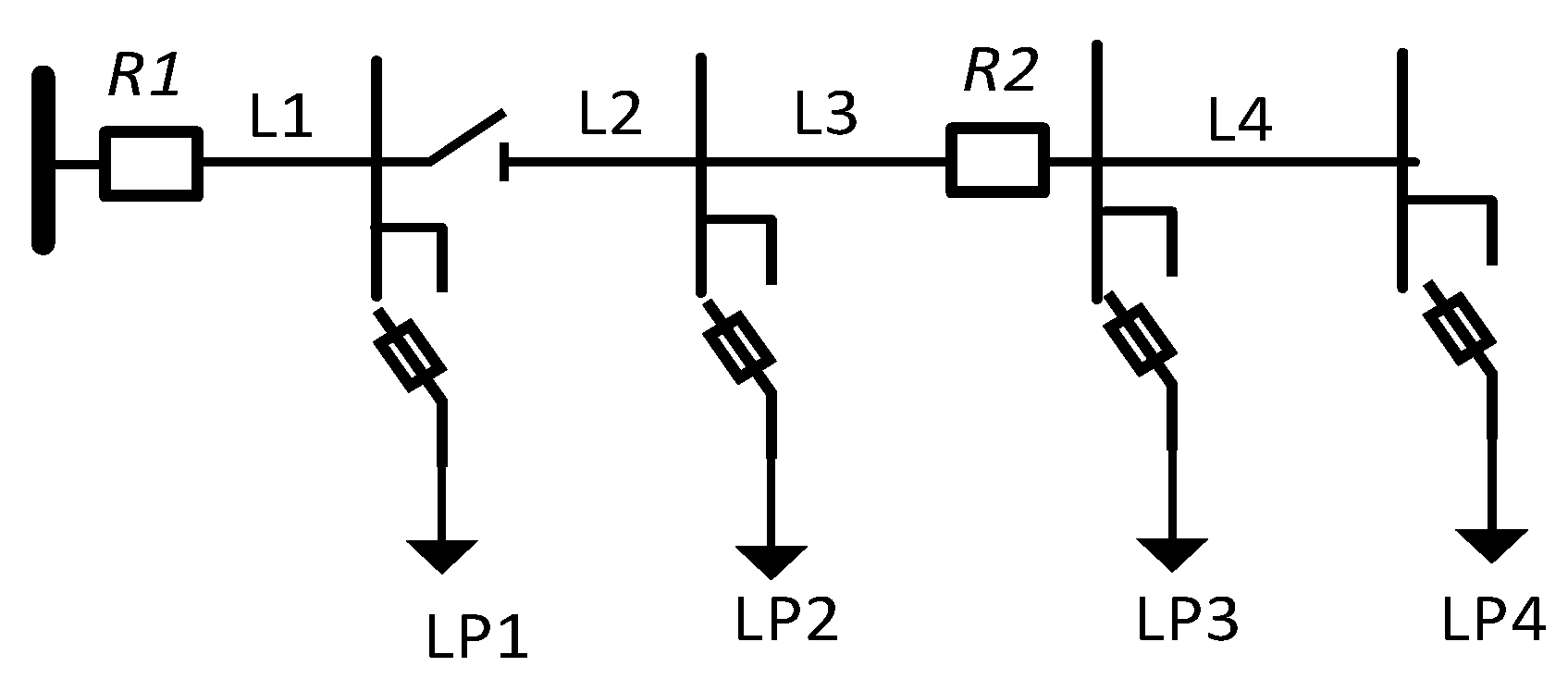

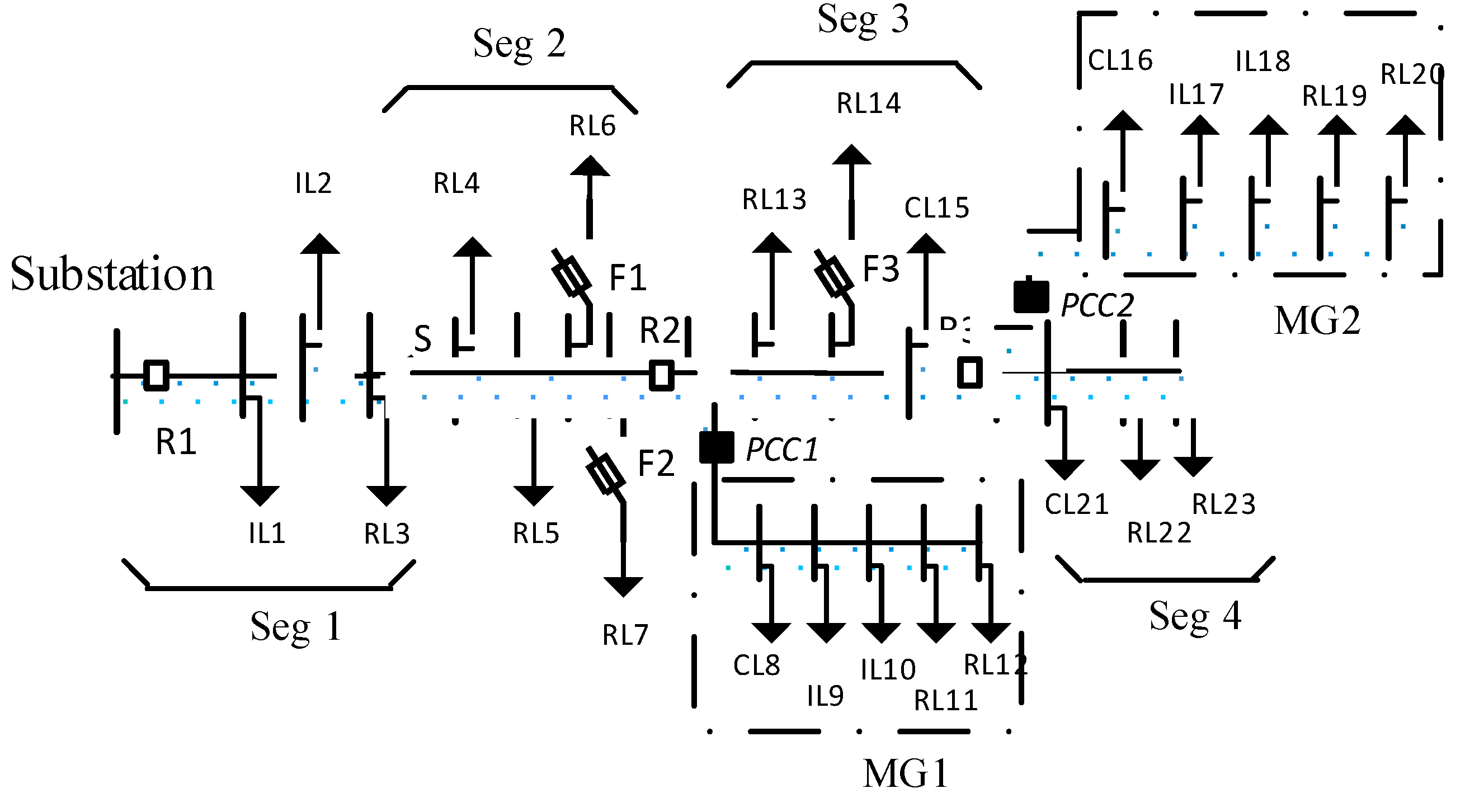
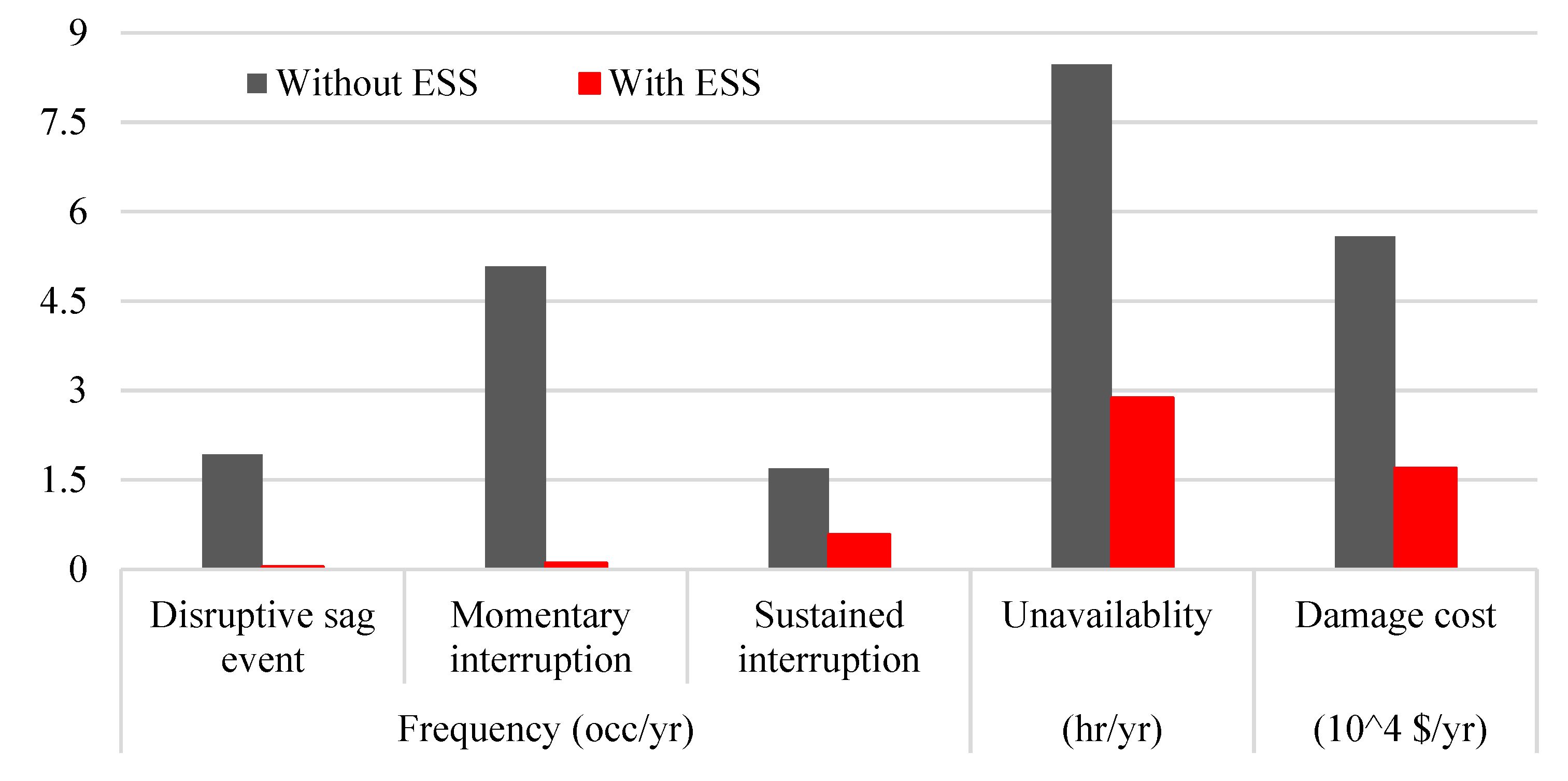
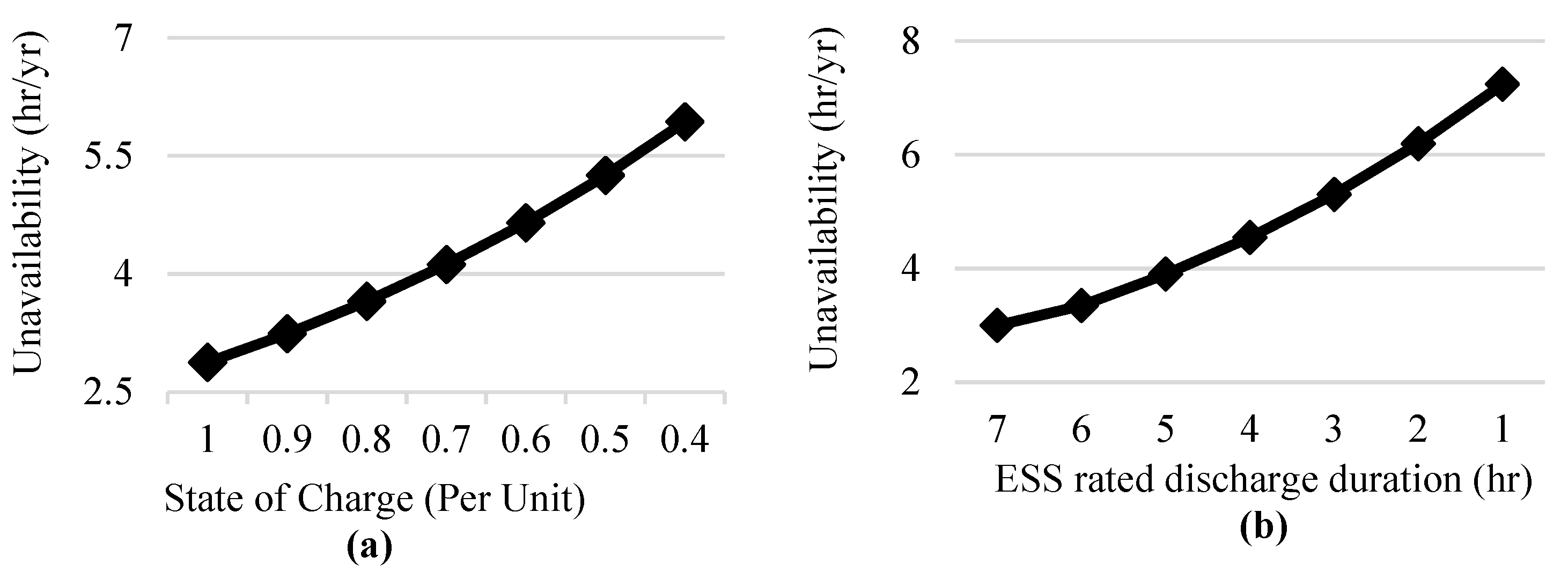

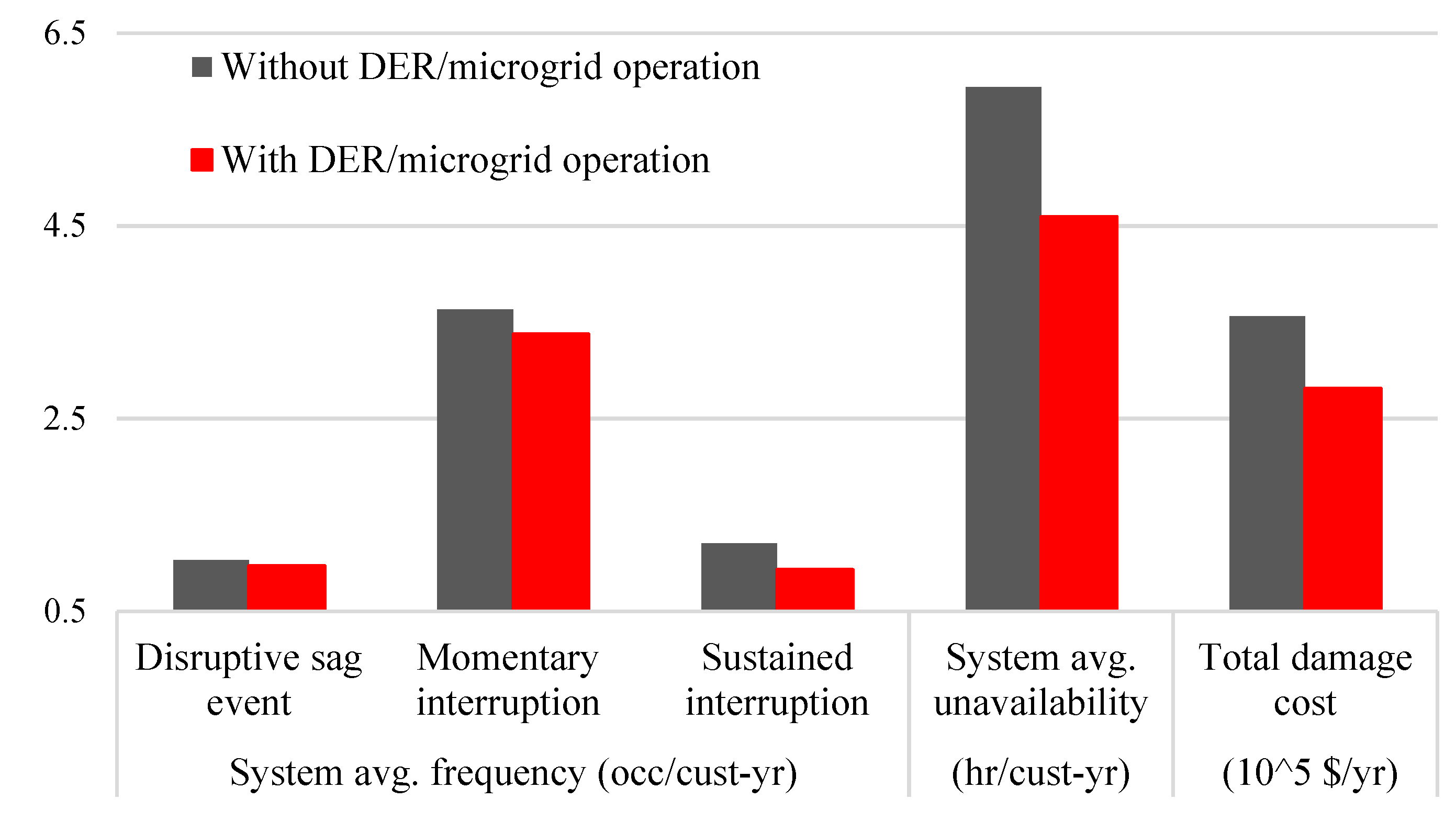
| Sector Type | Interruption Duration (minutes) | ||||
|---|---|---|---|---|---|
| 1 | 20 | 60 | 240 | 480 | |
| Industrial | 1.625 | 3.868 | 9.085 | 25.16 | 55.81 |
| Commercial | 0.381 | 2.969 | 8.552 | 31.32 | 83.01 |
| Residential | 0.001 | 0.093 | 0.482 | 4.914 | 15.69 |
| Segments | Wind Generator | PV Arrays | ESS |
|---|---|---|---|
| MG1, MG2 | 0.6 MW | 0.6 MW | 1.4 MW/9.8 MWhr |
| Seg3, Seg4 | 0.3 MW | 0.3 MW | 0.7 MW/4.9 MWhr |
| Segments/MG | FDSE (occ/cust-yr) | FMI (occ/cust-yr) | USI (hr/cust-yr) | Dtot (k$/yr) | |
|---|---|---|---|---|---|
| MG1 | Base case | 1.126 | 5.078 | 8.648 | 135.866 |
| Improvement (%) | 33.85 | 21.61 | 18.75 | 19.72 | |
| Seg3 | Base case | 1.116 | 3.243 | 5.531 | 15.619 |
| Improvement (%) | 0 | −10.34 | 30.31 | 29.63 | |
© 2019 by the authors. Licensee MDPI, Basel, Switzerland. This article is an open access article distributed under the terms and conditions of the Creative Commons Attribution (CC BY) license (http://creativecommons.org/licenses/by/4.0/).
Share and Cite
Gautam, P.; Piya, P.; Karki, R. Utilizing Energy Storage for Reliability Solutions in Active Distribution Systems. Appl. Sci. 2019, 9, 4392. https://doi.org/10.3390/app9204392
Gautam P, Piya P, Karki R. Utilizing Energy Storage for Reliability Solutions in Active Distribution Systems. Applied Sciences. 2019; 9(20):4392. https://doi.org/10.3390/app9204392
Chicago/Turabian StyleGautam, Prajjwal, Prasanna Piya, and Rajesh Karki. 2019. "Utilizing Energy Storage for Reliability Solutions in Active Distribution Systems" Applied Sciences 9, no. 20: 4392. https://doi.org/10.3390/app9204392
APA StyleGautam, P., Piya, P., & Karki, R. (2019). Utilizing Energy Storage for Reliability Solutions in Active Distribution Systems. Applied Sciences, 9(20), 4392. https://doi.org/10.3390/app9204392






